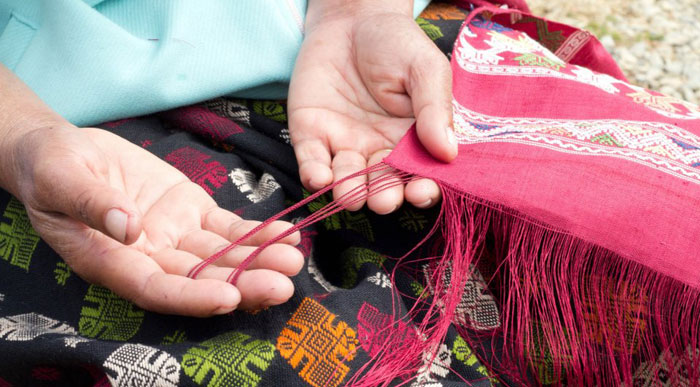Silk Story
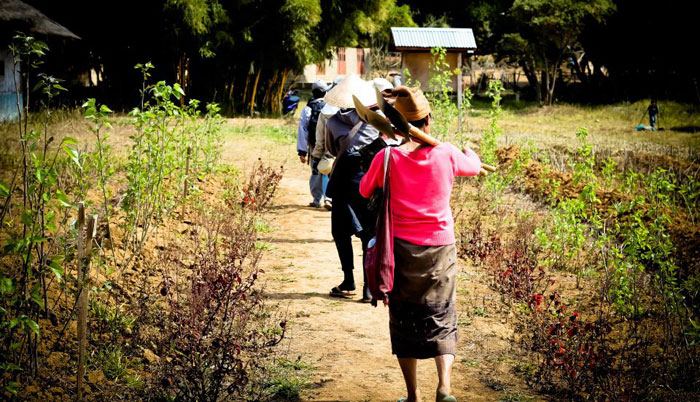
Photography by Fair Trade Connection
Village silk production is a cyclical process which utilizes local resources and supports all aspects of village life.
The Lao Sericulture Company works with village producers in order to ensure that the cycle remains environmentally sustainable and continues to be a positive impact in the community.
The cycle starts and ends with the planting of mulberry saplings. These saplings will produce fruit for dyes and eating, bark for tea, leaves for organic fertilizer and food for growing silkworms. The silkworms continue the cycle by producing cocoons and nutrient rich waste that can be used as fertilizer for mulberry and food crops.
Transforming cocoons into silk thread is the next step, and nothing is wasted in this process. The unreelable outer layer on the cocoon is saved to create stuffing in pillows and blankets. The silkworm pupae are enjoyed by the Lao villagers who find them an excellent source of protein. Even the silk water is saved as the women prize it as a skin moisturizer.
The new thread is dyed with natural dyes and then woven by skilled artisans. The resulting products are sold on local and foreign markets and the resulting surplus is cycled back to the villagers in the form of mulberry saplings, rearing tools, or training opportunities.
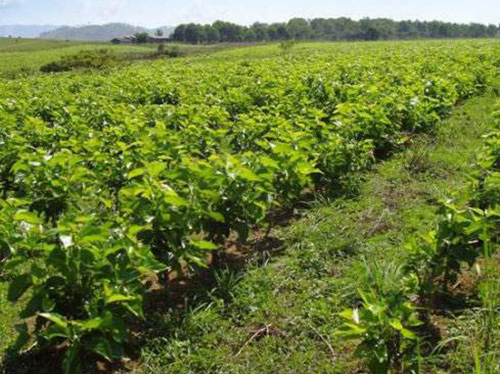
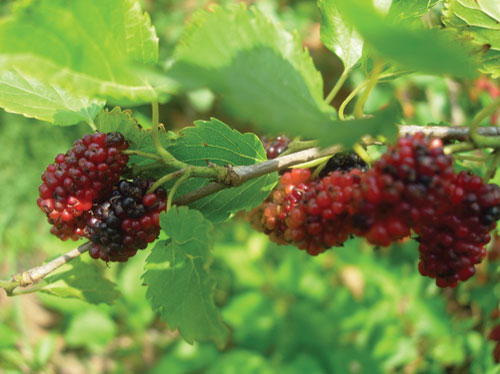
Mulberry Trees
Mulberry leaves are the sole source of nutrition for growing silkworms. They take water, protein, carbohydrates, fat, anorganic salts and vitamins from these leaves. If the silk producer is planning for a moderate (20,000 worm) silkworm harvest, s/he will plant around 2,000 cuttings and tend them for 8 months to a year before starting to raise silkworms. A producer must have 500-600 kg of leaves to feed 20,000 worms through their life cycle.
During the course of its short life, the silkworm will consume about 30,000 times its weight in mulberry leaves.
The trees are grown from 20-25 cm branch cuttings, which are carefully placed in the ground with organic compost. In order to keep the soil healthy, legume grass can also be planted around the cuttings. This prevents soil erosion, and adds nutrient-rich biomass to the topsoil. As the trees grow, they are constantly pruned in order to increase crop yield and keep the tree at a convenient height for harvesting.

Sustainable and Rewarding
The growing of mulberry trees is a sustainable and rewarding option for the Lao village farmer. It provides a sustainable alternative to both the customary practice of slash and burn agriculture (which has caused extensive deforestation and severe soil degradation) and the prevalent cash crop of opium poppies. When raised correctly, a crop of mulberry trees can rejuvenate the earth, prevent soil erosion, provide delicious mulberry fruit, and translate into a worthwhile profit for the farmer.
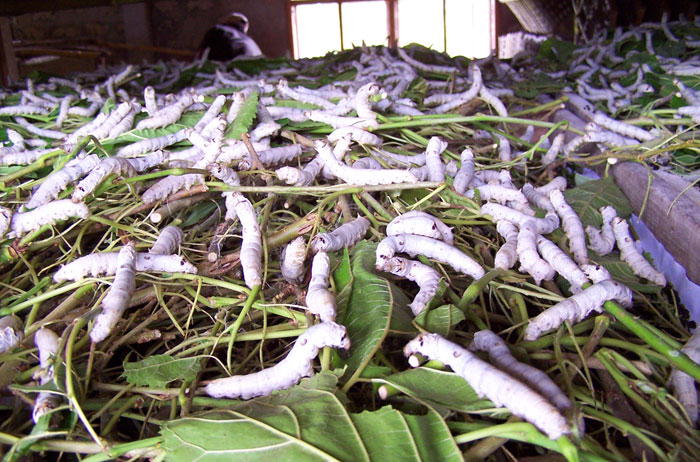
Rearing Houses
In order for the village producer to raise healthy silkworms, s/he must have a rearing house. The house will keep pests and diseases out, and maintain the temperature and humidity for silkworm development. These houses are primarily constructed from locally available materials, such as bamboo, and are built by the potential producer.
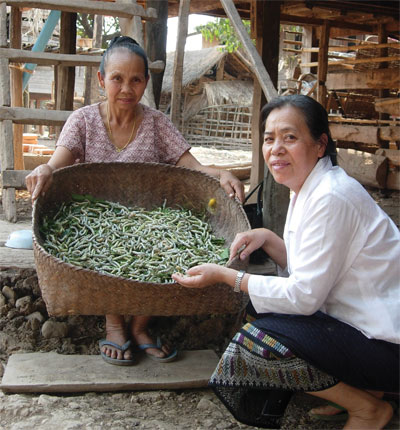
However, acquiring a rearing house is a big investment for the producer. It requires both a solid cement floor ($100-$150 U.S.) and adequate tools for raising silkworms ($50). Villagers often need an extension of credit in order to pay for these necessities. Credit is provided by the Lao Sericulture Company, in partnership with international non-governmental organizations. Given on the condition that when more people in the community wish to build their own rearing houses, the original producers will help them with the costs out of their own earnings from silk production.
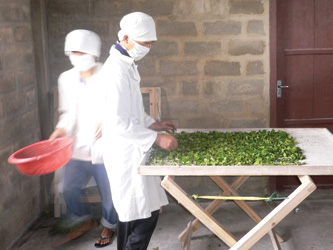
Silkworm Raising
The life cycle of the silk worm…. begins and ends with the egg. These eggs are about the size of a pinhead and are a milky white or a deep yellow colour when first laid, but then change to a grey colour tinged with dark purple after 6-7 days. A female silk moth lays around 200 eggs before dying. The young silk worms will normally hatch 12 days after the eggs are laid.
When the worm first emerges it is black, tiny – 3mm long – and delicate. This is the start of its 28 days of life – during which it will eat ravenously and grow to 10,000 times its original size. The worm will undergo 4 periods of moulting, each one lasting around 24 hours, during which the worm will neither eat nor move. During this period of growth, the village silk producer is very busy. Keeping the worms healthy and developing normally is more than a full time job.
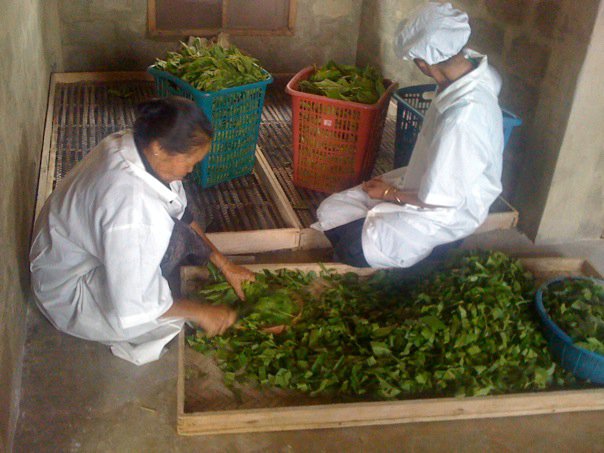
The worms must be fed 3 times a day on fresh mulberry leaves – morning, noon, and night. These leaves need to be specially prepared to meet the changing needs of the growing silkworm. When worms are young, they require finely chopped young leaves which are picked from the top of the mulberry tree. As they grow older, the leaf sections increase in size, and the leaves are gathered from further down the plant’s stem.
Silkworms are very sensitive to their surrounding environment. Even residual tobacco on the fingers of a silk worker could cause sickness amongst the worms.
Many factors contribute to the overall health of the worm, and the successful silk producer must manage them all with care. S/he must keep the rearing house free from disease and pests through regular cleaning, maintenance, and disinfection of tools and workers’ hands. The house must also be kept at a specific temperature, humidity and luminosity while preserving adequate ventilation. The worms must be spaced at the proper density on the feeding trays, and the trays should be kept free from excess waste and uneaten leafage. The worms must also be dusted with lime and papsol in order to prevent bacterial infection.
After around 28 days of hard work, the white worms have now grown to their full size of about 8cm long and 1.5cm wide. Soon they will turn a slightly yellowish hue and begin to look for a suitable place for creating their cocoon.
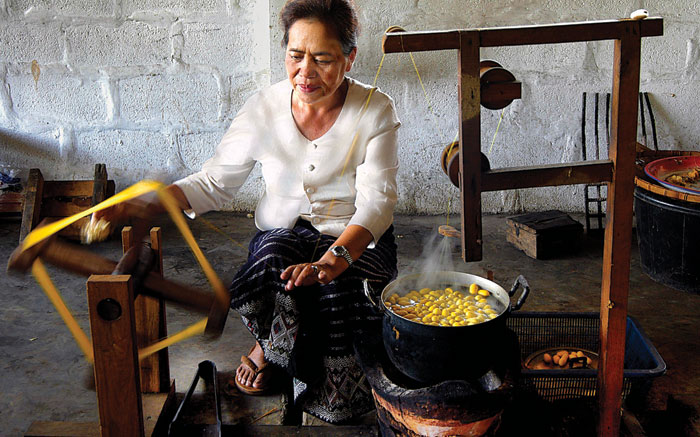
Photography by Paul Wager
Cocoons
Silkworms are very adaptive creatures and are able to build their cocoons on a variety of different surfaces in an assortment of creative ways. Although this works well for the silkworm, it does not always benefit the producer. Irregular cocoons are very hard to reel and much silk ends up wasted. Therefore, mounting must take place at the proper time with the proper apparatus.
There are many different forms of cocooning frames which can be used, the rotary and the zig-zag mountage are just two examples.
There are many different species of silkworms, all which possess unique characteristics. The traditional Lao silkworm produces a very short yellow strand that can only be reeled by hand. This process produces a breathable, soft silk with a comfortable linen-like texture.
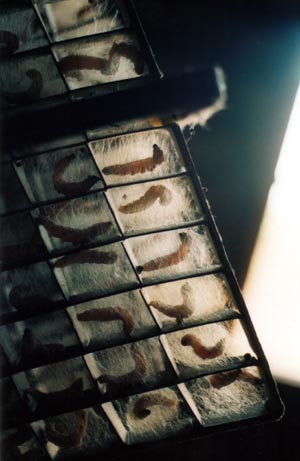
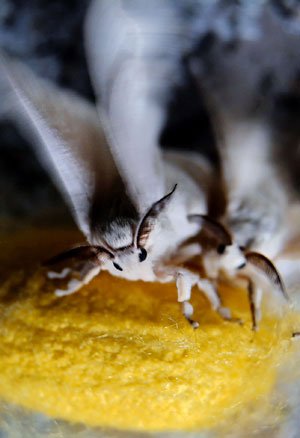
The worm builds its nest by secreting two filaments from its mouth. One is a very thin strand of silk, and the other is a cord of gum called sericin. When exposed to the air, the two harden together and become one length of thread. Over the course of 3 days, the worm will slowly envelope itself in a cocoon by winding one continuous thread about itself in a figure eight pattern. As the worms busy themselves by building cocoons, the silk producer is also busy ensuring that the worms are distributed evenly on the mountage and that all excreted waste is immediately disposed of.
Ready for Harvesting the Silk
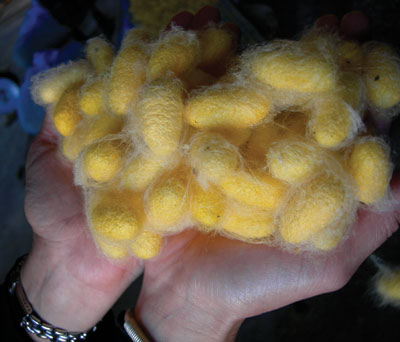
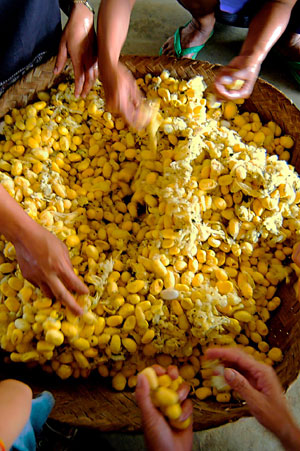
After 5 days, the worm has turned into a dark brown pupa and the cocoon is ready to be harvested. The cocoons are plucked from their trays and sorted according to their quality.
They are then cleaned and the outer floss – the loose threads surrounding the cocoon – is removed by hand. The floss is not thrown away, but is used for stuffing in blankets and pillows.
Reeling Silk
After being flossed and sorted, the cocoons are ready for the reeling pot. By placing the cocoons in boiling water, the reeler is able to loosen the sericin in order to unwind the fragile silk strands from the cocoon. With deft fingers, up to 100 strands are caught up together and pulled through simple tools in order to form one silk thread. This labour intensive process contributes to the distinct linen-like texture that handmade Lao silk possesses.
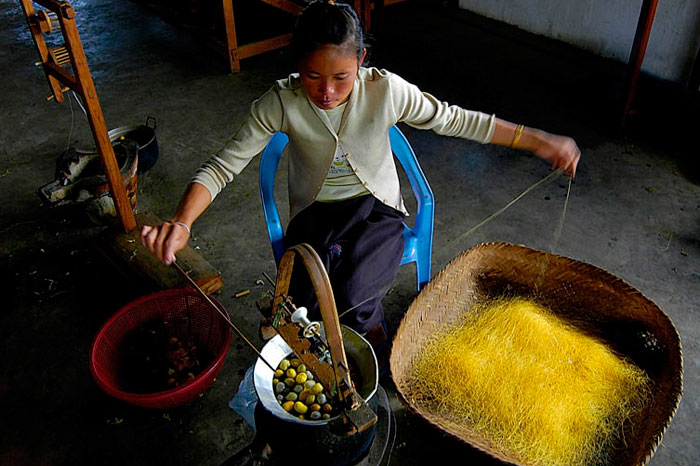
Photography by Fair Trade Connection
Cleaning & Softening
In order for the new silk thread to reveal its gentle texture, it must be soaked, cleaned and softened. The silk is first soaked in rice water in order to condition the thread and make it ready to absorb the natural dyes. Once it has soaked overnight, it is rinsed and hung in the shade to dry. Next, it is placed in a pot with ash water and boiled for many hours. This cleans the sericin off the silk, which creates a soft texture. The silk is now ready for weaving or dyeing.
The length of a silk strand can vary depending on the variety of cocoon.
- Traditional Lao Worm: 250m
- Lao & Thai Hybrid: 300-500m
- Japanese & Chinese Hybrid: 600m-800m
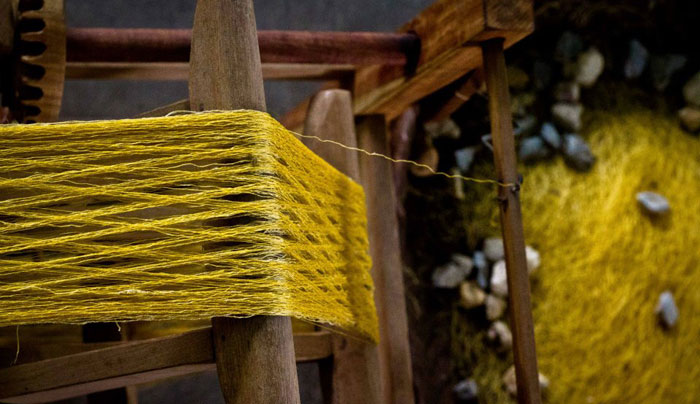
Photography by Fair Trade Connection
Twisting Thread
The strands of silk thread are now twisted together in order to make it strong enough for weaving. Silk can be twisted into a single or double thread, depending on the desired thickness and weight of the final material. Hand-twisting silk is an art that requires both patience and dexterity. The thread must be repeatedly wound around a spinning spindle and then pulled off, one small section at a time.
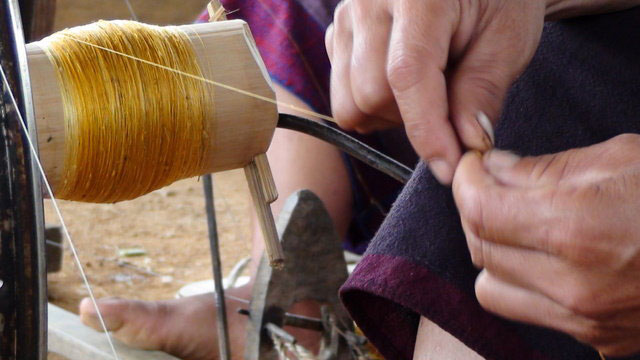
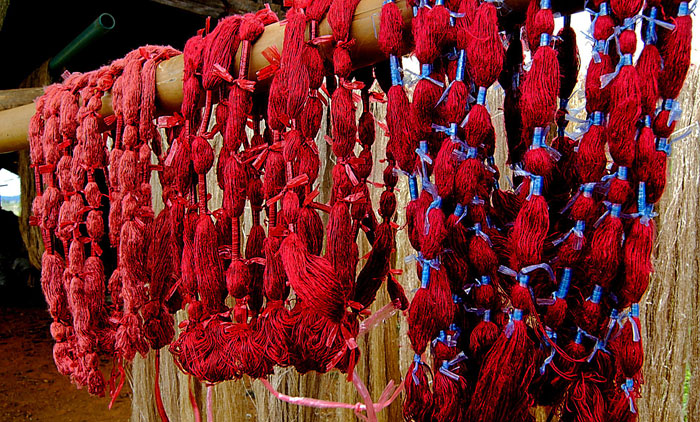
Natural Dyeing
Beautiful colour springs from unlikely places in the hands of natural dye specialists.
More on natural dyes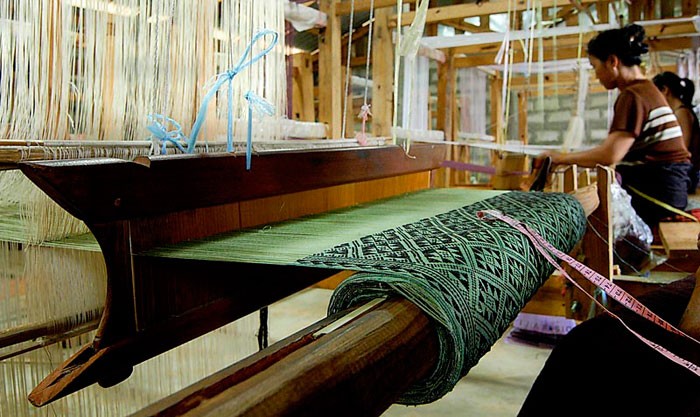
Weaving
With beating combs and dancing shuttles, the village weaver creates silk cloth and completes the cycle of silk production. Using skills learned from generations before, she operates the traditional loom with dexterity and grace.
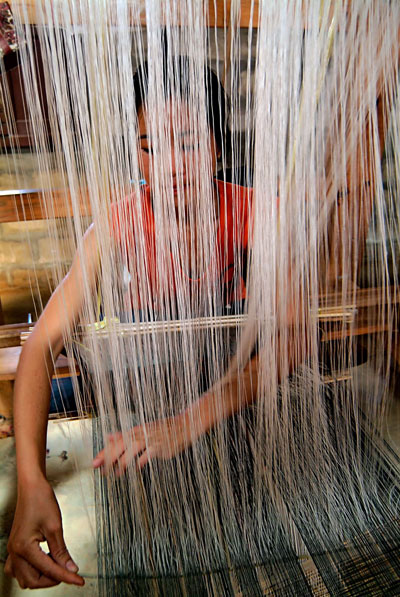
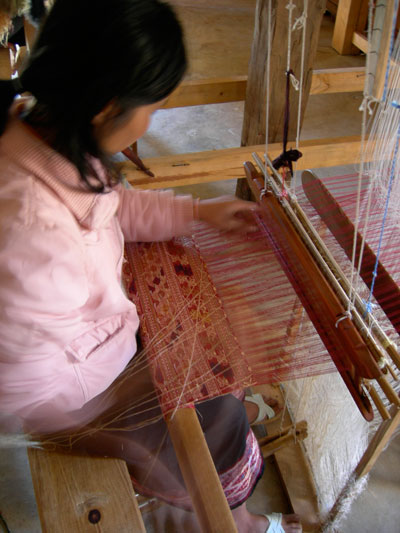
The first step of traditional weaving is the preparation of the loom. If the weaver is planning to weave about 30 m of 80cm wide cloth, she will spend around seven days painstakingly arranging thread through wefts and combs.
Once the loom is set up, she will start to weave whenever she has free time in her busy day. Most weavers are able to produce 1 to 1.2 m in an eight-hour hr period.
Village women favour this form of work because they are still able to watch their children and participate in village life. Also, working for the Lao Sericulture Company means that they will have a guaranteed buyer with an agreed on price. This is a welcome change in a country with a very uncertain market.
Creating the Fringe
